
DunavNET – poultryNET
ID: 4369
June 2, 2022
Artificial intelligence platform for increased animal welfare and sustainability in livestock production.
ID: 3849
December 21, 2021
ASTI Mobile Robotics is an international group of mobile robotics companies with expertise in industrial connectivity and automation of intralogistics. The engineering company was founded in 1982 in the provincial capital Burgos in Spain. The company has a workforce of over 330 employees and owns plants located across Spain, Germany, and France. ASTI offers solutions that cover the entire value chain and the intralogistics needs of today’s connected industry, covering both system analysis, design, manufacturing, deployment, and maintenance. Among an extensive portfolio of solutions is a noteworthy intralogistics system that is based on Automated Guided Vehicles (AGVs) and mobile robotics. These systems are used by industrial companies to move materials and products from one location to another within plants.
With a mission to improve the competitiveness, flexibility, and time to market of their customers, ASTI serves the needs of industrial companies from more than 20 countries in Europe, North America, South America, and Asia. The company relies on an extensive network of partners with whom they work closely to provide the most appropriate solutions for each individual client, and they invest heavily in R&D in order to keep the automated solutions at the forefront of technology. ASTI officially offers the market’s widest range of AGVs and has been awarded Europe’s leading mobile robotics manufacturer.

ASTI’s incentive to develop their IoT solution derives from a desire to optimise operating efficiency in industrial environments. In recent years, the Internet of Things has radically transformed industries and how they have previously been operating, communicating, and utilising data. Looking towards the future, ASTI expects industrial automation to explode, and therefore aspires to aid manufacturers in this transition by offering solutions that ease operational tasks, building on the company’s technological expertise and know-how.
“In the future industry, AGVs and robotic arms will have to interoperate and collaborate to execute production tasks.”
Julian Campo Sayes, Development Engineer at ASTI
The complex machinery and novel technologies that constitutes ASTI’s IoT solution has been designed and developed as part of the European project INGENIOUS, and with support from the project partners, the phase of implementation is proceeding at present.
ASTI’s solution coordinates the operation of a robotic arm and an AGV, which is an intricate matter of interoperability that relies on the 5G network. A 3D sensor is mounted in the robot to perceive the relative position of the AGV, and ultimately enable the machine to automatically perform a range of operational tasks.
Although deployment and evaluation of ASTI’s solution is still awaiting, its potential for future value creation in industrial environments is distinctive. The primary users will be manufacturers, covering all types of factories that use AGVs, and in particular the sections where the AGVs are installed as part of a production task that involves robotic arms.
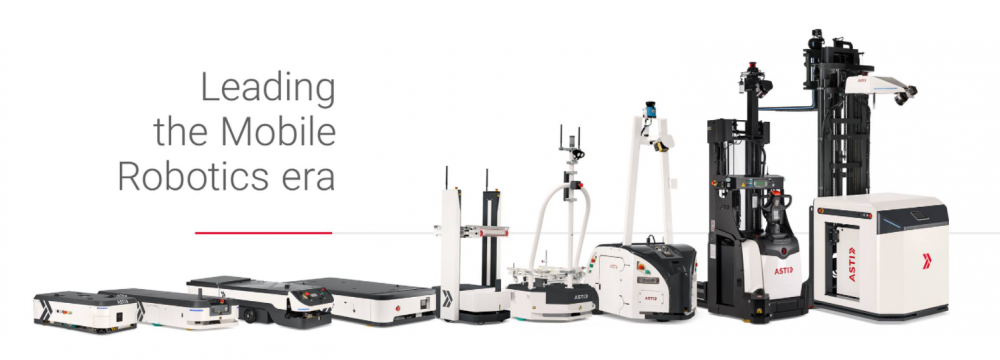
The solution offered by ASTI is, simply put, an AGV and a robotic arm that are built together to collaborate and take over some of the manual tasks, which are repetitious and often cumbersome, from plant workers.
The hardware of the solution entails the AGV, with encoders installed in its motors and battery; the robotic arm, with encoders installed in its joints; and a 3D sensor and camera that measures motion, location, and consumption. The functionality of the solution unfolds in a four-step-process of:
Hence, the AGV and the robotic arm will run as MEC applications, enabling the solution to benefit from real-time radio network information and in a cloud-based environment at the edge of the network with ultra-low latency and high-bandwidth. The physical components of ASTI’s solution, and the setting in which it is deployed, is connected to the network by a 5G modem. The data that is generated and collected by the AGV and the robotic arm is transferred via 5G to the MEC server, where the information is processed and analysed.
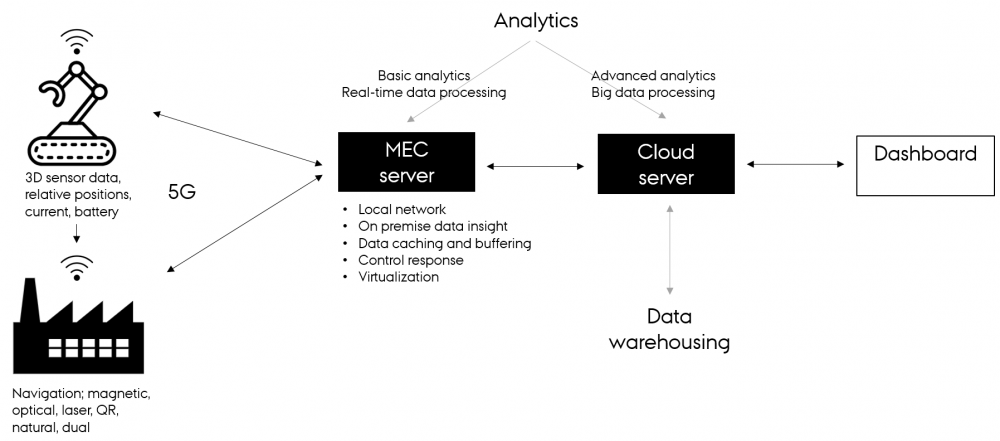
ASTI’s solution is functional as an isolated solution, but for its full potential to unfold, it needs to be properly integrated into the client’s plant and connected to the systems, production lines, terminals, and customer management systems used by the client.
Integration of ASTI’s solution into an existing plant could include:
The integration facilitates reliable and flexible vehicle location and navigation systems by enabling real-time communication and monitoring of every single data point, both throughout the solution and its industrial setting. Connecting the various systems of the client with ASTI’s solutions software system can then take a plant to another level of intelligence with optimized operations and processes and facilitated decision making.
The software system of the solution is divided into different modules which are responsible for performing the orders, regulating the priority of the movements of the AGV and robotic arm, managing bidirectional communication with all plant elements, and customer management systems. Applications of ASTI’s solutions software include:
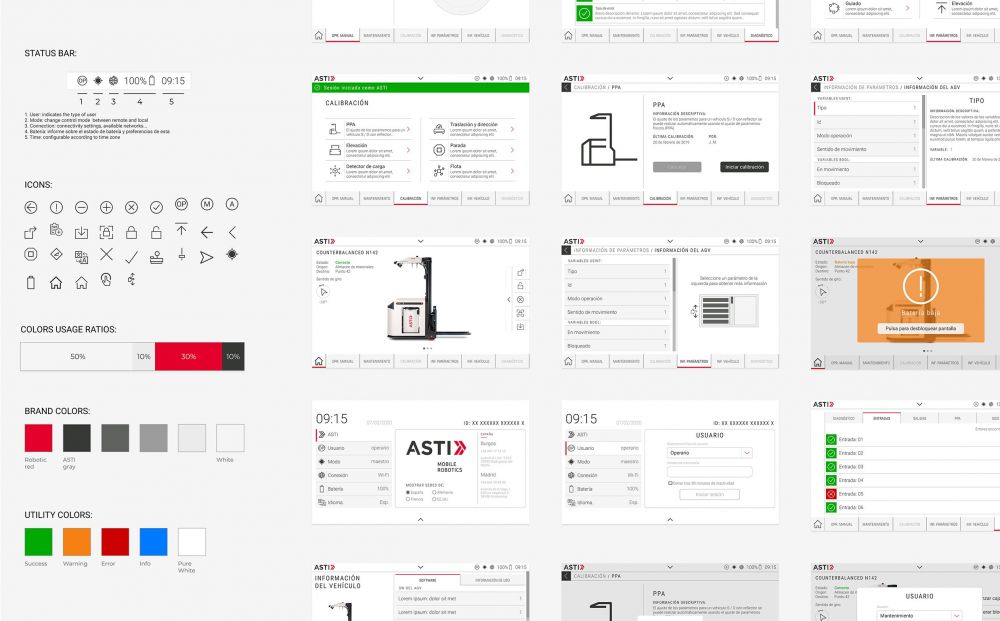
The development of ASTI’s IoT solution is a contribution to the industrial ambition of fostering intelligent production and the transformation towards Industry 4.0. By seamlessly connecting the digital and real world in industrial settings, the solution represents an initiator for enabling manufacturing in a more flexible, energy-efficient, resource-saving, individualized, and inexpensive manner.
“In the future, we will be able to offer a fully functional solution to our customers.”
Julian Campo Sayes, Development Engineer & Jimena Casas Pérez, Commercial Engineer at ASTI
Since the solution is not yet commercialised, it has not yet obtained any measurable outcomes in the market. However, the process of implementation and deployment of the solution is currently ongoing and running according to the plans. The R&D department and the commercial team at ASTI have collaborated closely throughout design, development, and implementation of the AGV robot, where needs and requirements from clients were also collected by the commercial team and transmitted to the R&D department. All immediate results indicate that the future commercialisation of ASTI’s solution will be a success.
The mission of ASTI to increase their customers’ productivity and optimize their competitiveness, flexibility, and time to market is manifested by the AGV robotics solution in one core outcome.
“Experiencing customer satisfaction when solving a specific need.”
Jimena Casas Pérez, Commercial Engineer at ASTI
A related outcome that ASTI strives for is long-term customer relationships based on continuous software support and services, rather than one-time sales of hardware. This, in combination with the company’s in-depth market knowledge and expertise in mobile robotics data analytics, enables a continuous profit mechanism on top of the direct sales of the solution. The commercialisation of this solution will furthermore serve as foundation for ASTI to develop new advanced solutions where robotic arms and AGVs cooperate.
For users of the solution, the direct outcome is a mobile robot, in terms of an AGV with a robotic arm, which is connected and integrated into the activities of their plant. The core value of the IoT implementation, however, is the data insights, optimisation capabilities, and automated functionalities that the solution brings to the client. The key end user features include:
The features of ASTI’s solution conform to the demands and requirements set by the market. The AGV robots become not only part of the client company’s intralogistics system, moving goods from one place to another, they also become part of the internal information system due to the data they generate and collect from which valuable insights can be extracted and the foundation for a smart production established. The AGV robot thereby constitutes the core element of the solution, whereas the software system grants entry to the desirable outcomes for the client, such as configuring customizable dashboards, performing monitoring and diagnosis, receive real-time operating alerts, remote updates, access via APIs, and connect to other data sources and visual interactive reports.
“Company processes, products and services are in continuous changes. So, we are prepared for continuous advances of the solution we provide.”
Jimena Casas Pérez, Commercial Engineer at ASTI

Since ASTI introduced the idea of a collaborative AGV and robotic arm to ease operational tasks and aid manufacturers in the Industry 4.0 transition, many technological iterations have passed, and many valuable learnings have transpired. Since the solution is now in the realm of implementation, the journey continues for ASTI.
“We are in continuous learning by doing!”
Julian Campo Sayes, Development Engineer & Jimena Casas Pérez, Commercial Engineer at ASTI
ASTI has a hands-on approach to learning, meaning that the company seeks for their solutions to interact with their environment in order to adapt and develop. Working with complex machinery and novel technologies, ASTI emphasises the importance of continuous testing and iteration in real scenarios. Collaborative thematic ecosystems, such as the INGENIOUS project, provides a safe environment and competent support for such solutions to reach commercialisation successfully.
ASTI considers a number of points to be vital for the success of their IoT solution so far. Taking departure in the journey of development and implementation, these points are compiled into a list of recommendations below:
1. Well established plan from the beginning
Setting a clear course of action is essential in making sure that intentions are redeemed. ASTI finds that establishing a plan that covers all phases, from idea to commercialisation, and rely on a well-considered and thought-out foundation, is a guide to achieve success.
2. Alignment with customer needs
“Continuous communication with final users! It is essential to keep them updated on the last functionalities that our solutions provide.”
Jimena Casas Pérez, Commercial Engineer at ASTI
The solution offered by ASTI heavily relies on the value of its applicability and usefulness for the customer, and hence, the development of the solution relies on conforming to needs and demands. However, because the technology is novel and complex, the company finds it essential to inform the clients about the potentials of the solutions as well. Bilateral communication is key.
3. Use IoT to advance
ASTI recommends IoT developers to combine internal know-how with IoT. Success lies in combining unique capabilities with traditional solutions that have already penetrated the market and infuse it with IoT to create added value. This is the case at least for ASTI, as the company has used IoT to build on top and advance their current product offering.
“The most important advancements are the coordination of AGVs and robotic arms as MEC applications.”
Julian Campo Sayes, Development Engineer at ASTI
Orchestrating the machinery by a central controller in MEC is an essential attribute for the success of the solution. This specific attribute offers low robust application latency end-to-end, real-time insights from data at the point of capture, minimum cloud ingress bandwidth, maximum transaction rate between the device and local cloud, local communications to private networks for performance, privacy, and security, and finally, optimal facilitation of M2M application and coordination between cloud and edge.
IoT, principally in terms of the MEC server, drives the solution by enabling remote control, reducing hardware costs, and deploying all benefits provided by the virtualization management [5]. This advanced capability of the solution is according to ASTI the foundation for its success.
“IoT solutions are the future and companies must be prepared to integrate them in their processes, products and services offered. Otherwise, they will be left behind in the market.”
Jimena Casas Pérez, Commercial Engineer at ASTI
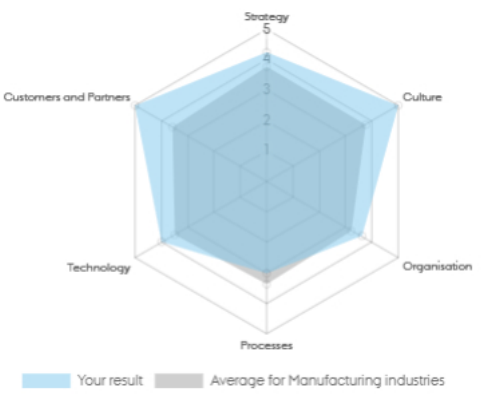
ASTI assumes a high level of digital maturity with an overall score of 4.14. The score indicates that the digital capabilities of the company are vastly mature, and that they perform above average for the manufacturing sector.
The Digital Maturity Assessment Tool is copyrighted by Associate Professor and PhD Annabeth Aagaard, Director at the Interdisciplinary Centre for Digital Business Development, Aarhus University. To get the digital maturity of your company mapped out, click here.
[1] MEC (Multi-access edge computing): Cloud-based IT services environment at the edge of the network. Enables applications to benefit from real-time radio network information and provides ultra-low latency and high-bandwidth.
[2] ERP (Enterprise Resource Planning): Software system applied to manage day-to-day business activities such as accounting, procurement, project management, risk management, and supply chain operations.
[3] MRP (Material Requirements Planning): Software system applied as planning and decision-making tool in the production process which analyses current inventory levels vs production capacity and the need to manufacture goods, based on forecasts.
[4] MES (Manufacturing execution system): Computerized system applied in manufacturing to track and document the transformation of raw materials to finished goods. Connects and monitors machines and work centres on the plant floor.
[5] Virtualization management: Software that interfaces with virtual environments and the underlying physical hardware to simplify resource administration, enhance data analyses, and streamline operations. Each virtualization management system is unique, but most feature an uncomplicated user interface, streamline the virtual machine (VM) creation process, monitor virtual environments, allocate resources, compile reports, and automatically enforce rules.
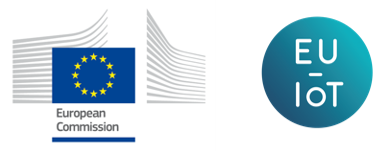
Copyright notice: © 2020 – 2023 EU-IoT Consortium.
This material was produced as part of the EU-IoT project, grant ID 956671, and is funded by the Horizon 2020 Framework Programme under topic ID ICT-56-2020.
EU-IoT is the European IoT Hub. The EU-IoT project works towards growing a sustainable and comprehensive ecosystem for Next Generation Internet of Things.
Source of origin: Information to document this use case originates from the H2020 call: ICT-56-2020 Next Generation Internet of Things (RIA); Project INGENIOUS 957216; Period: 01-11-2020 to 31-03-2023; EC contribution 8 mil. EUR.
